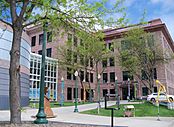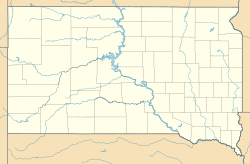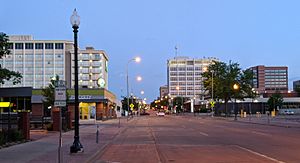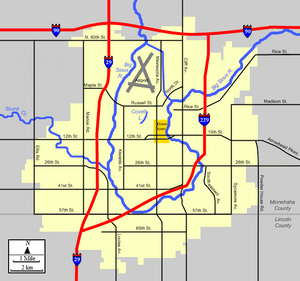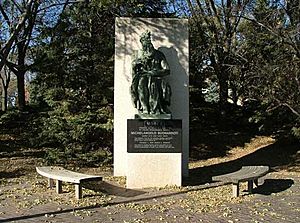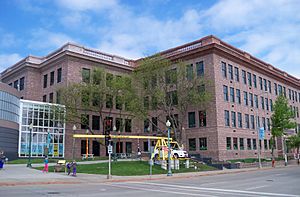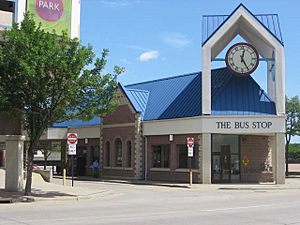Sioux Falls, South Dakota facts for kids
Quick facts for kids
Sioux Falls, South Dakota
|
|||||
|---|---|---|---|---|---|
|
Sioux Falls skyline as seen from Falls Park
Old Minnehaha County Courthouse
Denny Sanford Premier Center
|
|||||
|
|||||
| Nickname(s):
Best Little City in America, Queen City of the West, The Heart of America
|
|||||
| Country | United States | ||||
| State | South Dakota | ||||
| Counties | Minnehaha | ||||
| Founded | 1856 | ||||
| Incorporated | February 4, 1879 | ||||
| Named for | The waterfall of the Big Sioux River | ||||
| Area | |||||
| • City | 81.19 sq mi (210.27 km2) | ||||
| • Land | 80.64 sq mi (208.87 km2) | ||||
| • Water | 0.54 sq mi (1.40 km2) | ||||
| Elevation | 1,463 ft (446 m) | ||||
| Population
(2020)
|
|||||
| • City | 192,517 | ||||
| • Estimate
(2023)
|
206,410 | ||||
| • Rank | US: 121st SD: 1st |
||||
| • Density | 2,387.25/sq mi (921.72/km2) | ||||
| • Urban | 194,283 (US: 197th) | ||||
| • Urban density | 2,861.3/sq mi (1,104.8/km2) | ||||
| • Metro | 289,592 (US: 171st) | ||||
| • Metro density | 112.5/sq mi (43.42/km2) | ||||
| Demonym(s) | Siouxlander (unofficial) | ||||
| Time zone | UTC–6 (Central (CST)) | ||||
| • Summer (DST) | UTC–5 (CDT) | ||||
| ZIP codes |
Zip codes
|
||||
| Area code(s) | 605 | ||||
| Sales tax | 6.2% | ||||
| GNIS feature ID | 1267566 | ||||
Sioux Falls (/ˌsuː ˈfɔːlz/ soo-_-fawlz) is the most populous city in the U.S. state of South Dakota and the 118th-most populous city in the United States. It is the county seat of Minnehaha County and also extends into northern Lincoln County to the south, which continues up to the Iowa state line. The population was 192,517 at the 2020 census, and in 2022, its estimated population was 202,078. According to city officials, the estimated population had grown to 213,891 as of early 2024. The Sioux Falls metro area accounts for more than 30% of the state's population. Chartered in 1856 on the banks of the Big Sioux River, the city is situated in the rolling hills at the junction of interstates 29 and 90.
Contents
History
The history of Sioux Falls revolves around the cascades of the Big Sioux River. The falls were created about 14,000 years ago during the last ice age. The lure of the falls has been a powerful influence. Ho-Chunk, Ioway, Otoe, Missouri, Omaha (and Ponca at the time), Quapaw, Kansa, Osage, Arikira, Dakota, and Cheyenne people inhabited and settled the region previous to Europeans and European descendants. Numerous burial mounds still exist on the high bluffs near the river and are spread throughout the general vicinity. Indigenous people maintained an agricultural society with fortified villages, and the later arrivals rebuilt on many of the same sites that were previously settled. Lakota populate urban and reservation communities in the contemporary state and many Lakota, Dakota, and numerous other Indigenous Americans reside in Sioux Falls today.
French voyagers/explorers visited the area in the early 18th century. The first documented visit by an American of European descent was by Philander Prescott, who camped overnight at the falls in December 1832. Captain James Allen led a military expedition out of Fort Des Moines in 1844. Jacob Ferris described the Falls in his 1856 book "The States and Territories of the Great West".
Two separate groups, the Dakota Land Company of St. Paul and the Western Town Company of Dubuque, Iowa organized in 1856 to claim the land around the falls, considered a promising townsite for its beauty and water power. Each laid out 320-acre (1.3 km2) claims, but worked together for mutual protection. They built a temporary barricade of turf which they dubbed "Fort Sod", in response to native tribes attempting to defend their land from the settlers. Seventeen men then spent "the first winter" in Sioux Falls. The following year the population grew to near 40.
Although conflicts in Minnehaha County between Native Americans and white settlers were few, the Dakota War of 1862 engulfed nearby southwestern Minnesota. The town was evacuated in August of that year when two local settlers were killed as a result of the conflict. The settlers and soldiers stationed here traveled to Yankton in late August 1862. The abandoned townsite was pillaged and burned.
Fort Dakota, a military reservation established in present-day downtown, was established in May 1865. Many former settlers gradually returned and a new wave of settlers arrived in the following years. The population grew to 593 by 1873, and a building boom was underway in that year. The Village of Sioux Falls, consisting of 1,200 acres (4.9 km2), was incorporated in 1876 and was granted a city charter by the Dakota Territorial legislature on March 3, 1883.
The arrival of the railroads ushered in the great Dakota Boom decade of the 1880s. The population of Sioux Falls mushroomed from 2,164 in 1880 to 10,167 at the close of the decade. The growth transformed the city. A severe plague of grasshoppers and a national depression halted the boom by the early 1890s. The city grew by only 89 people from 1890 to 1900.
But prosperity eventually returned with the opening of the John Morrell meat packing plant in 1909, the establishment of an airbase and a military radio and communications training school in 1942, and the completion of the interstate highways in the early 1960s. Much of the growth in the first part of the 20th century was fueled by agriculturally based industry, such as the Morrell plant and the nearby stockyards (one of the largest in the nation).
In 1955 the city decided to consolidate the neighboring incorporated city of South Sioux Falls. At the time South Sioux Falls had a population of nearly 1,600 inhabitants, according to the 1950 census. It was the third largest city in the county after Sioux Falls and Dell Rapids. By October 18, 1955, South Sioux Falls residents voted 704 in favor and 227 against to consolidate with Sioux Falls. On the same issue, Sioux Falls residents voted on November 15 by the vote 2,714 in favor and 450 against.
In 1981, to take advantage of recently relaxed state usury laws, Citibank relocated its primary credit card center from New York City to Sioux Falls. Some claim that this event was the primary impetus for the increased population and job growth rates that Sioux Falls has experienced over the past quarter-century. Others point out that Citibank's relocation was only part of a more general transformation of the city's economy from an industrially based one to an economy centered on health care, finance, and retail trade.
Sioux Falls has grown at a rapid pace since the late 1970s, with the city's population increasing from 81,182 in 1980 to 192,517 in 2020.
2019 tornadoes
On the night of September 10, 2019, the south side of Sioux Falls was hit by three EF-2 tornadoes, severely damaging at least 37 buildings, including the Plaza 41 Shopping Center. One tornado hit the Avera Heart Hospital, damaging portions of the roof and windows, and causing 7 injuries, including a man who fractured his skull as he was thrown into an exterior wall of the hospital. Another tornado hit the busy commercial district near the Empire Mall, injuring one woman inside her home. Another touched down on the far south side in a suburban residential area, tearing the roofs off homes. The total damage was more than $5 million.
Geography
Sioux Falls is located at 43°32'11" North, 96°43'54" West (43.536285, −96.731780). According to the United States Census Bureau, the city has a total area of 73.47 square miles (190.29 km2), of which 72.96 square miles (188.97 km2) is land and 0.51 square miles (1.32 km2) is water. The city is in extreme eastern South Dakota, about 15 miles (24 km) west of the Minnesota border. Sioux Falls has been assigned the ZIP Codes 57101, 57103–57110, 57117–57118, 57188–57189, and 57192–57198, and the FIPS place code 59020.
Metropolitan area
The Sioux Falls Metropolitan Statistical Area consists of four South Dakota counties: Lincoln, McCook, Minnehaha, and Turner. The estimated population of this MSA in 2017 was 259,094, an increase of 13.51% from the 2010 census. According to recent estimates, Lincoln County is the 16th-fastest-growing county in the United States. In addition to Sioux Falls, the metropolitan area includes Canton, Brandon, Dell Rapids, Tea, Harrisburg, Worthing, Beresford, Lennox, Hartford, Crooks, Baltic, Montrose, Salem, Renner, Rowena, Chancellor, Colton, Humboldt, Parker, Hurley, Garretson, Sherman, Corson, Viborg, Irene, and Centerville.
Parks and recreation
Sioux Falls has more than 70 parks and greenways. These include Falls Park, established around the city's namesake waterfalls on the Big Sioux River, just north of downtown. Other parks include Terrace Park, McKennan Park, Sherman Park, and Yankton Trail park. The park system includes a paved 19-mile (31 km) path used for biking, jogging, and walking. The path follows the course of the Big Sioux River, forming a loop around Sioux Falls, along with a few spurs off the main bike trail. Recently the city stepped up efforts to beautify a stretch of the bike trails through downtown along an area known as the River Greenway. Two of three planned phases of construction and updates have occurred. Among the updates were newer widened bike paths, new landscaping and lighting, improved street access to the bike trails, a new interactive fountain, a new pedestrian bridge across the river, removal of the old "River Ramp" parking structure, new stepped terraces leading down to the river's edge, new retaining walls along portions of the river, and a new amphitheater and performing space. New trailheads at Elmen, Dunham, and Lien parks have helped to improve access to outlying trail spurs. The city is expanding the bike trail network east from Sioux Falls at Lien Park to Brandon, South Dakota, and ultimately the Big Sioux Recreation Area. The South Dakota Department of Game, Fish, and Parks has an outdoor campus in Sioux Falls at Sertoma Park with several outdoor areas and acreages devoted to fish and wildlife. The outdoor campus hosts many outdoor activities, including stargazing and snowshoeing. During the winter, Great Bear Recreation Park offers skiing, snowboarding, and tubing.
Climate
Due to its inland location and relatively high latitude and elevation, Sioux Falls experiences a humid continental climate (Köppen Dfa) characterized by hot, humid summers and cold, dry winters. It is in USDA Plant Hardiness Zone 4b. The monthly daily average temperature ranges from 17.9 °F (−7.8 °C) in January to 74.4 °F (23.6 °C) in July; there are 15 days of maxima at or above 90 °F (32 °C) and 25 days with minima at or below 0 °F (−18 °C) annually. Snowfall occurs mostly in light to moderate amounts during the winter, totaling 45.3 inches (115 cm). Precipitation, at 27.85 inches (707 mm) annually, is concentrated in the warmer months. This results in frequent thunderstorms in summer from convection being built up with the unstable weather patterns. Extremes range from −42 °F (−41 °C) on February 9, 1899 to 110 °F (43 °C) as recently as June 21, 1988.
| Climate data for Sioux Falls (Foss Field Airport), elevation: 436 m or 1,430 ft, 1991–2020 normals, extremes 1893–present | |||||||||||||
|---|---|---|---|---|---|---|---|---|---|---|---|---|---|
| Month | Jan | Feb | Mar | Apr | May | Jun | Jul | Aug | Sep | Oct | Nov | Dec | Year |
| Record high °F (°C) | 66 (19) |
70 (21) |
88 (31) |
98 (37) |
104 (40) |
110 (43) |
110 (43) |
109 (43) |
104 (40) |
94 (34) |
82 (28) |
63 (17) |
110 (43) |
| Mean maximum °F (°C) | 47 (8) |
53 (12) |
70 (21) |
82 (28) |
88 (31) |
93 (34) |
95 (35) |
94 (34) |
90 (32) |
82 (28) |
67 (19) |
50 (10) |
97 (36) |
| Mean daily maximum °F (°C) | 27.2 (−2.7) |
32.0 (0.0) |
45.0 (7.2) |
59.0 (15.0) |
70.8 (21.6) |
80.9 (27.2) |
85.3 (29.6) |
82.8 (28.2) |
75.6 (24.2) |
61.1 (16.2) |
45.0 (7.2) |
31.6 (−0.2) |
58.0 (14.4) |
| Daily mean °F (°C) | 17.9 (−7.8) |
22.3 (−5.4) |
34.7 (1.5) |
47.2 (8.4) |
59.1 (15.1) |
69.9 (21.1) |
74.4 (23.6) |
72.0 (22.2) |
63.8 (17.7) |
49.6 (9.8) |
34.8 (1.6) |
22.5 (−5.3) |
47.4 (8.6) |
| Mean daily minimum °F (°C) | 8.5 (−13.1) |
12.6 (−10.8) |
24.3 (−4.3) |
35.5 (1.9) |
47.5 (8.6) |
58.8 (14.9) |
63.4 (17.4) |
61.1 (16.2) |
51.9 (11.1) |
38.1 (3.4) |
24.5 (−4.2) |
13.4 (−10.3) |
36.6 (2.6) |
| Mean minimum °F (°C) | −16 (−27) |
−10 (−23) |
−1 (−18) |
18 (−8) |
31 (−1) |
44 (7) |
49 (9) |
47 (8) |
34 (1) |
20 (−7) |
4 (−16) |
−9 (−23) |
−19 (−28) |
| Record low °F (°C) | −38 (−39) |
−42 (−41) |
−23 (−31) |
4 (−16) |
17 (−8) |
32 (0) |
34 (1) |
34 (1) |
13 (−11) |
−5 (−21) |
−17 (−27) |
−31 (−35) |
−42 (−41) |
| Average precipitation inches (mm) | 0.60 (15) |
0.83 (21) |
1.60 (41) |
3.00 (76) |
3.86 (98) |
4.23 (107) |
3.25 (83) |
3.34 (85) |
2.73 (69) |
2.36 (60) |
1.22 (31) |
0.83 (21) |
27.85 (707) |
| Average snowfall inches (cm) | 8.0 (20) |
8.6 (22) |
7.2 (18) |
5.1 (13) |
0.1 (0.25) |
0.0 (0.0) |
0.0 (0.0) |
0.0 (0.0) |
0.0 (0.0) |
1.4 (3.6) |
6.2 (16) |
8.7 (22) |
45.3 (115) |
| Average precipitation days (≥ 0.01 in) | 7.0 | 7.0 | 8.2 | 10.2 | 12.1 | 11.8 | 9.0 | 9.4 | 8.1 | 7.9 | 6.2 | 7.0 | 103.9 |
| Average snowy days (≥ 0.1 in) | 7.3 | 6.8 | 5.1 | 2.2 | 0.1 | 0.0 | 0.0 | 0.0 | 0.0 | 0.9 | 3.5 | 6.9 | 32.8 |
| Average relative humidity (%) | 71.7 | 73.3 | 72.1 | 64.5 | 63.5 | 65.4 | 65.4 | 67.9 | 69.5 | 67.2 | 73.4 | 75.5 | 69.1 |
| Average dew point °F (°C) | 6.4 (−14.2) |
12.6 (−10.8) |
23.4 (−4.8) |
33.6 (0.9) |
44.8 (7.1) |
55.2 (12.9) |
60.6 (15.9) |
58.8 (14.9) |
49.5 (9.7) |
36.9 (2.7) |
24.4 (−4.2) |
12.0 (−11.1) |
34.9 (1.6) |
| Average ultraviolet index | 1 | 2 | 4 | 5 | 7 | 8 | 9 | 8 | 6 | 3 | 2 | 1 | 5 |
| Source 1: NOAA (relative humidity and dew point 1961–1990) | |||||||||||||
| Source 2: Weather Atlas (UV index) | |||||||||||||
Demographics
| Historical population | |||
|---|---|---|---|
| Census | Pop. | %± | |
| 1880 | 2,164 | — | |
| 1890 | 10,177 | 370.3% | |
| 1900 | 10,266 | 0.9% | |
| 1910 | 14,094 | 37.3% | |
| 1920 | 25,202 | 78.8% | |
| 1930 | 33,362 | 32.4% | |
| 1940 | 40,832 | 22.4% | |
| 1950 | 52,969 | 29.7% | |
| 1960 | 65,466 | 23.6% | |
| 1970 | 72,488 | 10.7% | |
| 1980 | 81,182 | 12.0% | |
| 1990 | 100,814 | 24.2% | |
| 2000 | 123,975 | 23.0% | |
| 2010 | 153,888 | 24.1% | |
| 2020 | 192,517 | 25.1% | |
| 2023 (est.) | 206,410 | 34.1% | |
| U.S. Decennial Census 2020 Census |
|||
2020 census
| Race / Ethnicity (NH = Non-Hispanic) | Pop 2000 | Pop 2010 | Pop 2020 | % 2000 | % 2010 | % 2020 |
|---|---|---|---|---|---|---|
| Non-Hispanic White alone (NH) | 112,703 | 130,577 | 149,423 | 90.91% | 84.85% | 77.62% |
| Black or African American alone (NH) | 2,198 | 6,412 | 12,069 | 1.77% | 4.17% | 6.27% |
| Native American or Alaska Native alone (NH) | 2,558 | 3,831 | 4,745 | 2.06% | 2.49% | 2.46% |
| Asian alone (NH) | 1,467 | 2,724 | 5,269 | 1.18% | 1.77% | 2.74% |
| Pacific Islander alone (NH) | 49 | 75 | 69 | 0.04% | 0.05% | 0.04% |
| Some Other Race alone (NH) | 95 | 169 | 534 | 0.08% | 0.11% | 0.28% |
| Mixed Race or Multi-Racial (NH) | 1,818 | 3,273 | 8,139 | 1.47% | 2.13% | 4.23% |
| Hispanic or Latino (any race) | 3,087 | 6,827 | 12,269 | 2.49% | 4.44% | 6.37% |
| Total | 123,975 | 153,888 | 192,517 | 100.00% | 100.00% | 100.00% |
As of the census of 2020, there were 192,517 people and 86,565 households in the city.
2010 census
As of the census of 2010, there were 153,888 people, 61,707 households, and 37,462 families residing in the city. The population density was 2,109.2 inhabitants per square mile (814.4/km2). There were 66,283 housing units at an average density of 908.5 per square mile (350.8/km2). The racial makeup of the city was 86.8% White, 4.2% African American, 2.7% Native American, 1.8% Asian, 0.1% Pacific Islander, 2.0% from other races, and 2.5% from two or more races. Hispanic or Latino of any race were 4.4% of the population.
There were 61,707 households, of which 31.9% had children under the age of 18 living with them, 45.5% were married couples living together, 10.9% had a female householder with no husband present, 4.4% had a male householder with no wife present, and 39.3% were non-families. 30.6% of all households were made up of individuals, and 8.7% had someone living alone who was 65 years of age or older. The average household size was 2.40 and the average family size was 3.02.
The median age in the city was 33.6 years. 24.6% of residents were under the age of 18; 10.7% were between the ages of 18 and 24; 29.7% were from 25 to 44; 24.1% were from 45 to 64; and 10.9% were 65 years of age or older. The gender makeup of the city was 49.6% male and 50.4% female.
In 2015, the median household income in Minnehaha County, SD was $59,884, while Lincoln County, SD was $76,094. This represents a 0.29% growth from the previous year. The median family income for Sioux Falls was $74,632 in 2015. Males had a median income of $40,187 versus $31,517 for females. The per capita income for the county was $26,392. 11.8% of the population and 8.5% of families were below the poverty line. Out of the total population, 16.8% of those under the age of 18 and 8.8% of those 65 and older were living below the poverty line.
Many European immigrants, primarily from Scandinavia, Germany and the British Isles, settled in South Dakota in the 19th century. By 1890, one-third of the residents of South Dakota were immigrants.
Religion
Most Sioux Falls residents are Lutheran, with Catholics being the second-largest group. The Evangelical Lutheran Church in America is the largest Lutheran denomination in the city, with 20 churches in Sioux Falls: First Lutheran Church, Church on the Street, Pueblo de Dios, Augustana Lutheran Church, St. Dysmas Of South Dakota Lutheran Church, East Side Lutheran Church, St. John American Lutheran Church, Hope Lutheran Church, Augustana Campus Congregation Lutheran Church, First Lutheran African Ministry, Our Savior's Lutheran Church, St. Mark's Lutheran Church, Grace Lutheran Church, Messiah New Hope Lutheran Church, Peace Lutheran Church, Westside Lutheran Church, Spirit Of Joy, Holy Cross Lutheran Church, Gloria Dei Lutheran Church, and Springdale Lutheran Church.
The Lutheran Church - Missouri Synod has eight churches in Sioux Falls: Memorial Lutheran Church, Faith Lutheran Church, Christ Lutheran Church, Lord Of Life Lutheran Church, Our Redeemer Lutheran Church, Resurrection Lutheran Church, Zion Lutheran Church, and Trinity Lutheran Church of the Deaf.
The Wisconsin Evangelical Lutheran Synod has two churches in Sioux Falls: Bethel Lutheran Church and Good Shepherd Lutheran Church.
The Roman Catholic Diocese of Sioux Falls, one of two dioceses in the state, built St. Joseph Cathedral on Duluth Avenue beginning in 1915 and completed in 1919. Sioux Falls is also the seat of the Episcopal Diocese of South Dakota.
As of 2021, the Church of Jesus Christ of Latter-day Saints has three congregations meeting in one meeting house in southwest Sioux Falls.
Sioux Falls has a small Hindu population served by the Hindu Temple of Siouxland in Tea, South Dakota.
The Chabad Jewish Center of South Dakota has been based in the city since December 24, 2016 and serves the entire state of South Dakota and its Jewish population, which is estimated at between 400 and 1,000.
There are three Islamic centers in the city, the Muslim Community Center of South Dakota (MCCSD), Islamic Center of Sioux Falls (ICSF), and Masjid Attaqwa. All observe the five daily prayers and some weekend activities for adults and children.
Economy
Top employers
According to the city's 2022 Comprehensive Annual Financial Report, the largest employers in the city are:
| # | Employer | Industry | # of Employees | Percentage |
|---|---|---|---|---|
| 1 | Sanford Health | Health Care | 11,010 | 6.9% |
| 2 | Avera Health | Health Care | 7,888 | 4.9% |
| 3 | Sioux Falls School District | Education | 3,688 | 2.1% |
| 4 | Smithfield Foods (John Morrell) | Meat Processing | 3,400 | 2.3% |
| 5 | Hy-Vee | Retail Grocery | 2,806 | 1.8% |
| 6 | Wells Fargo | Financial | 2,035 | 1.3% |
| 7 | Walmart/Sam's Club | Retail | 1,547 | 1.0% |
| 8 | City of Sioux Falls | Government | 1,477 | 0.9% |
| 9 | Citigroup | Financial | 1,400 | 0.8% |
| 10 | Department of Veterans Affairs Medical & Regional Office | Medical | 1,214 | 0.9% |
| — | Total employers | — | 36,465 | 22.8% |
Partially due to the lack of a state corporate income tax, Sioux Falls is home to a number of financial companies. The largest employers among these are Wells Fargo and Citigroup.
While no longer as economically dominant as it once was, the manufacturing and food processing sector remains an important component of Sioux Falls' economy. The Smithfield Foods/John Morrell meatpacking plant is the city's third-largest employer.
Arts and culture
Events
Downtown Sioux Falls hosts a SculptureWalk every summer and "First Fridays" on the first Friday of each summer month. The Downtown Riverfest brings live music, art, kids' activities and more in an annual festival that embraces the beauty of the Big Sioux.
Festival of Bands is a regional competition that hosts over 40 marching bands each year from across the Midwest. The Sioux Empire Spectacular is a Drum Corps regional competition. Party in the Park is an annual outdoor musical event held at Terrace Park. The Sioux Empire Fair is a regional fair held at the W. H. Lyon Fairgrounds, and the Sioux Falls JazzFest is hosted at Yankton Trail Park each year.
SiouxperCon is an annual nonprofit fan convention that celebrates comic books, sci-fi, fantasy, anime, board games, and video gaming.
Arts
In the beginning of the 21st century, Sioux Falls experienced a renaissance of cultural interest. The Sioux Empire Arts Council continues to lead in the Sioux Falls area arts scene and gives out Mayor's Awards each year in several categories for excellence demonstrated by Sioux Falls residents. The Sioux Falls SculptureWalk was the first visual evidence of the renaissance and is an attraction for both visitors and resident artists, hosting over 55 sculptures including a replica of the Michelangelo's David. Work was essential to the renovation of the original Washington High School into the Washington Pavilion (housing two performing arts, a visual arts, and a science center).
The Northern Plains Indian Art Market (NPIAM) was established in 1988 by American Indian Services, Inc., of Sioux Falls as the Northern Plains Tribal Arts Show (NPTA). Northern Plains Tribal Arts dominated the Sioux Falls art scene from its inception in 1988. American Indian Services produced the juried art show and market from 1988 to 2003. Since 2004, Sinte Gleca University of Rosebud has been the producing organization. In the first 25 years of its existence—one of the longest-running Indian art shows in the country—over 800 artists from 7 northern plains states and two Canadian provinces exhibited at NPTA/NPIAM. Writers for national publications, filmmakers, and researchers have all joined the audiences over the years.
A permanent Northern Plains Tribal Arts collection is housed in the Egger Gallery at the Washington Pavilion. Since the Washington Pavilion opened its doors to the public in 1999, the collection has called the Visual Arts Center home. Originally the pieces were on an extended loan from American Indian Services, Inc.; in 2013, thanks to many supporters, the works were acquired under the title of the Augustana Tribal Arts Collection, and now officially belong to the Visual Arts Center.
As the 21st century began, poetry and literary events became more popular with the opening of the Sioux Empire Arts Council Horse Barn Gallery and due to a National Endowment for the Arts-supported Y Writer's Voice. The Y Writer's Voice included an annual reading series of 38 nationally known poets and writers, who performed works and youth workshops through the Sioux Falls Writers Voice in local performance spaces, at the YMCA after-school program, and in local schools, gaining national attention.
The Sioux Falls mayor's awards in literary arts designated movers and shakers during the growth and development of the literary arts scene. In addition to literary awards, there are mayor's awards in visual arts, performing arts, music, organizing in the arts, advocacy, and lifetime achievement, per the mayor's discretion.
The Sioux Falls Jazz and Blues Festival is a three-day outdoor musical event featuring two stages and is free to the public. It is held the third weekend in July at Yankton Trail Park. The Sioux Falls Jazz & Blues Society hosts national musicians during its annual concert series. Each year the series includes approximately five concerts with acts from all over the world. JazzFest, with over 125,000 in annual attendance, has expanded over the years to include the Jazziest Diversity Project, the All-City Jazz Ensemble, the Concert Series, and JazzFest Jazz Camp. 2016 was the festival's 25th anniversary year.
In 2019, Levitt at the Falls launched its first season of free concerts in a state-of-the-art outdoor amphitheater in Falls Park West. Downtown Sioux Falls boasts Ipso Gallery. the Orpheum Theater, SculptureWalk, The Premiere Playhouse, The Good Night Theatre Collective, Sioux Falls State Theater, the Museum of Visual Materials, the Interactive Water Fountain, Falls Park, Creative Spirits, Eastbank Art Gallery, Levitt at the Falls, and the Washington Pavilion, home to the South Dakota Symphony Orchestra, the occasional Poets & Painters show, and the Spotlight Theatre Collective (formerly known as the Dakota Academy of Performing Arts.)
Landmarks
The Washington Pavilion contains the Kirby Science Discovery Center, as well as two performing arts centers that host several Broadway productions and operas. The South Dakota Symphony's home hosts dance groups as well as smaller theater and choral events. The Visual Arts Center, also part of the Pavilion complex, hosts six galleries of changing exhibits, all free of charge. The Wells Fargo Cinedome is a multi-format 60 ft (18 m) dome theater that plays several films each month. The Cinedome also hosts the Sweetman Planetarium which has at least one show played everyday.
The Great Plains Zoo & Delbridge Museum provides the area with natural history and animal exhibits in its 50-acre (200,000 m2) park. The taxidermy animals once hosted within the Delbridge Museum were removed in 2023 due to health concerns of the high amounts of arsenic in the mounts.
The USS South Dakota Battleship Memorial to the World War II battleship USS South Dakota is on State Highway 42 (West 12th Street) and Kiwanis Avenue.
The 114th Fighter Wing is at Joe Foss Field and houses F-16C/D fighter aircraft. The SD ANG unit is known for its support of community activities and services.
A replica of Michelangelo's David is near the downtown area at Fawick Park.
Sports
| Club | League | Venue | Established | Championships |
|---|---|---|---|---|
| Sioux Falls Canaries | AAIPB, Baseball | Sioux Falls Stadium | 1993 | 1 |
| Sioux Falls Stampede | USHL, Ice hockey | Denny Sanford Premier Center | 1999 | 3 |
| Sioux Falls Storm | IFL, Indoor football | Denny Sanford Premier Center | 2000 | 11 |
| Sioux Falls Skyforce | NBA G League, Basketball | Sanford Pentagon | 1989 | 3 |
| Sioux Falls Thunder FC | NPSL, Soccer | McEneaney Field | 2017 | 0 |
| Sioux Falls City FC | WPSL, Soccer | University of Sioux Falls | 2022 | 0 |
The Sioux Falls Canaries were known as the Sioux Falls Fighting Pheasants from 2010 to 2013. Patrick Mahomes Sr. pitched for the Sioux Falls Canaries in 2007 and 2008.
Special sporting events
Sioux Falls has several multipurpose athletic stadiums: the primarily baseball Sioux Falls Stadium, indoor Sioux Falls Arena, indoor Sanford Pentagon, and indoor Denny Sanford Premier Center. Sioux Falls Stadium hosted the 2007 American Association of Independent Professional Baseball all-star game.
Constructed in 2014, the Denny Sanford Premier Center is home to the Summit League's men's and women's basketball tournaments. The Premier Center also hosted the 2016 Division I Women's Tournament Regional as well as the 2017 USHL/NHL Top Prospects Game.
Education
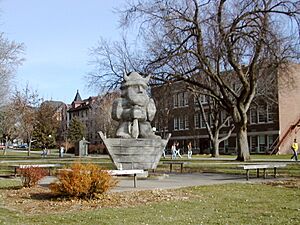
Higher education
Sioux Falls is home to Augustana University, the University of Sioux Falls, Sioux Falls Seminary, Southeast Technical College, National American University, the South Dakota School for the Deaf, the University of South Dakota's Sanford School of Medicine (Sioux Falls campus), Stewart School and the South Dakota Public Universities and Research Center (formerly known as USDSU).
Public schools
The Sioux Falls School District, which covers the majority of Sioux Falls, serves over 23,000 students living in Sioux Falls and some of its surrounding suburbs. There are 25 elementary schools, seven middle schools, and six high schools, including:
- Axtell Park Building
- Career and Technical Education Academy
- Lincoln High School
- Roosevelt High School
- Jefferson High School
- Washington High School
Other school districts in Minnehaha County which cover parts of Sioux Falls include: Tea Area School District 41-5, Brandon Valley School District 49-2, Tri-Valley School District 49-6, and Lennox School District 41-4. Within Lincoln County, other districts which cover parts of Sioux Falls include Tea Area and Harrisburg School District 41-2.
Private schools
Bishop O'Gorman Catholic Schools is a centralized Catholic school system that includes eight schools: six elementary schools, all PreK-6 (St. Mary, St. Lambert, St. Michael-St. Katharine Drexel, Holy Spirit and Christ the King); one junior high (O'Gorman Junior High, grades 7–8); and one high school, O'Gorman (9–12). The junior and senior high O'Gorman schools are on the same campus. Approximately 2,800 students attend Bishop O'Gorman Catholic Schools. As of the 2009–10 school year the Sioux Falls Catholic School system's St. Joseph Cathedral School was closed.
The Lutheran Church-Missouri Synod operates two schools in Sioux Falls. Sioux Falls Lutheran School is on 37th street, while the Lutheran High School of Sioux Falls is on Western Avenue. In 2018, voters approved a plan to move Sioux Falls Lutheran School to a new building near the I-29/I-229 merge on south Boe Lane. Students moved to the new building at the beginning of the Spring 2020 semester.
The Wisconsin Evangelical Lutheran Synod has two schools in Sioux Falls: Bethel Lutheran and Good Shepherd Lutheran.
Other private schools include Sioux Falls Christian Schools, Christian Center, The Baan Dek Montessori, Cornerstone School, and the Open Arms Christian Child Development Center.
Media
Infrastructure
Transportation
Roads
Most Sioux Falls residents travel and commute by car. Interstate 90 passes east to west across the northern edge of the city, while Interstate 29 bisects the western portion of the city from the north and south. Interstate 229 forms a partial loop around Sioux Falls, and connects with I-90 to the northeast and I-29 to the southwest. A grid design system for city streets is the standard for the central (older) area of the city; secondary streets in newer residential areas have largely abandoned this plan.
Due to current and expected regional growth, several large construction projects have been or will be undertaken. New interchanges have recently been added to I-29. An interchange was also completed on I-90 at Marion Road. I-29 has recently been improved from I-90 to 57th Street. This upgrade includes additional lanes and auxiliary lanes. Over the next decade, the city of Sioux Falls and the South Dakota Department of Transportation plan to construct a limited-access highway around the city's outer edges to the south and east, known as South Dakota Highway 100. This highway will start at the northern Tea exit (Exit 73 on I-29, 101st Street), run east on 101st Street, curve northeast east of Western Avenue, then turn north near Sycamore Avenue. It will end at the Timberline Avenue exit (Exit 402 on I-90). Sioux Falls' major roads include W 41st, Minnesota, Main, W 26th (which becomes Louise as it turns south), 12th, 49th, 57th, and Western.
Public/mass transit
Sioux Area Metro, the local public transit organization, operates 16 bus lines within the city, with most routes operating Monday through Saturday. Recently, the city added a new transfer station in Sioux Falls on Louise Avenue between 49th and 57th Streets. The Sioux Area Metro Paratransit serves members of the community who would otherwise not be able to travel by providing door-to-door service. Public transportation is supplemented with the SAM On Demand service that offers microtransit options.
Jefferson Lines runs long-distance bus routes to the Sioux Falls Bus Station. Non-transfer destinations include Grand Forks, Kansas City, Minneapolis, and Omaha. Until 1965 a branch of the Milwaukee Road train from Chicago, the Arrow, made a stop in Sioux Falls.
Air
Many domestic airlines serve Sioux Falls Regional Airport.
Rail
The BNSF Railway provides freight rail service. Amtrak does not serve any community in South Dakota.
Notable people
- James Abourezk, first Arab-American U.S. senator, practiced law in Sioux Falls
- Erika M. Anderson, aka EMA, musician and digital media artist
- Jacob M. Appel, author, wrote Coulrophobia & Fata Morgana while living in Sioux Falls
- Shayna Baszler, former MMA fighter and professional wrestler
- George Botsford, composer and pianist, noted for the "Black and White Rag"
- Chris Browne, comic strip artist and cartoonist, Hägar the Horrible
- Benny Castillo, 11-year minor league baseball player and manager
- Dallas Clark, professional football player
- Devin Clark, UFC mixed martial artist
- Donn Clendenon, MLB first baseman
- Dusty Coleman, MLB infielder
- Brian Cummings, voice actor
- George Jonathan Danforth, South Dakota politician
- Chris Darrow, multi-instrumentalist and singer-songwriter
- Karl Dean, former mayor of Nashville, Tennessee
- Nick Dinsmore, WWE Superstar 1999–2009 and WWE coach 2012–2015
- William Dougherty, South Dakota politician
- Wallace Dow, architect
- Walker Duehr, professional ice hockey player, played in the National Hockey League
- Oscar Randolph Fladmark, World War II and Korean War fighter pilot, recipient of the Distinguished Flying Cross (United States)
- James D. Ford, former Chaplain of the United States House of Representatives
- Terry Forster, pitcher for five MLB teams
- Joe Foss, World War II "ace of aces" fighter pilot, first commissioner of the American Football League; 20th governor of South Dakota
- Michael E. Fossum, astronaut
- Neil Graff, quarterback for several NFL teams
- George Barnes Grigsby, delegate to Congress from Alaska Territory
- John T. Grigsby, Lieutenant Governor of South Dakota
- Melvin Grigsby, American Civil War and Spanish–American War veteran who served as Attorney General of South Dakota
- Sioux K. Grigsby, Lieutenant Governor of South Dakota
- Donald A. Haggar, lawyer and legislator
- Mary Hart, television personality, Entertainment Tonight
- Allison Hedge Coke, writer and educator
- Stephanie Herseth Sandlin, U.S. representative from South Dakota's at-large congressional district, current President of Augustana University
- Crystal Johnson, state's attorney for Minnehaha County
- January Jones, actress, best known for playing Betty Draper on Mad Men
- Herbert Krause, author (1905–1976)
- David Lillehaug, associate justice of the Minnesota Supreme Court and Attorney General of Minnesota
- Mike Martz, former head coach of NFL's St. Louis Rams, born in Sioux Falls
- Gail Matthius, actress, cast member on Saturday Night Live
- Milton J. Nieuwsma, author, screenwriter, producer
- Pat O'Brien, television personality, Access Hollywood
- A. J. Rosier, Wyoming state senator
- David Soul, actor, co-star of Starsky & Hutch
- David Stenshoel, musician (Boiled in Lead)
- Joan Tabor, actress
- John Thune, South Dakota senator
- Shane Van Boening, professional pool player
- Jerry verDorn, actor, Guiding Light and One Life to Live
Sister cities
Sioux Falls' sister cities are:
 Newry, Mourne and Down District Council, Northern Ireland, United Kingdom
Newry, Mourne and Down District Council, Northern Ireland, United Kingdom Potsdam, Germany
Potsdam, Germany
See also
 In Spanish: Sioux Falls para niños
In Spanish: Sioux Falls para niños




